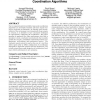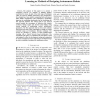79 search results - page 10 / 16 » Heterochrony and Adaptation in Developing Neural Networks |
ATAL
2008
Springer
13 years 9 months ago
2008
Springer
Due to computational intractability, large scale coordination algorithms are necessarily heuristic and hence require tuning for particular environments. In domains where character...
CEC
2007
IEEE
14 years 1 months ago
2007
IEEE
—The purpose of this paper is to present a comparison between two methods of building adaptive controllers for robots. In spite of the wide range of techniques which are used for...
ALIFE
2004
13 years 7 months ago
2004
Turn-taking behavior is simulated in a coupled-agents system. Each agent is modeled as a mobile robot with two wheels. A recurrent neural network is used to produce the motor outpu...
BMCBI
2006
13 years 7 months ago
2006
Background: Particle Swarm Optimization (PSO) is an established method for parameter optimization. It represents a population-based adaptive optimization technique that is influen...
TNN
1998
13 years 7 months ago
1998
—Adaptive resonance theory (ART) describes a family of self-organizing neural networks, capable of clustering arbitrary sequences of input patterns into stable recognition codes....


